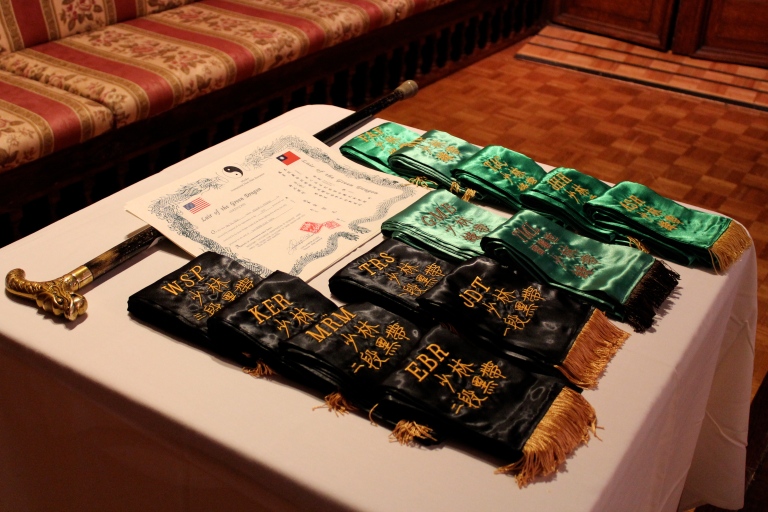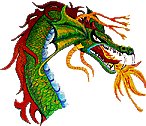- Home
- From The Sifu
- On Promotion
From The Sifu

Prior to the dissolution of the Wong Publishing Enterprise and, accordingly, Inside Kung-Fu Magazine, they had requested an article from Sifu in reference to his views on standards for promotion and/or standards for more equitable judging in tournament competition. Aware of his strong views on these subjects, they expected a thorough analysis in historical perspective. What follows is the first of three installments which together comprise the full article, which had not yet been submitted before the demise of the magazine.
In an article in Black Belt Magazine many years ago, and in many similar articles by others in the intervening time, Sifu John Funk, certainly no stranger to successfully organizing major competitions on a large scale, wrote critically regarding both the state and process of ranking in the kung-fu arts. While there was a great deal of truth and insight in Sifu Funk’s negative evaluation of the path(s) to promotion in the Chinese systems, as opposed to any of the karate styles, he neglected to discuss three very extensive and germane points (there are many others!) which need to be factored in, which render promotional standards and procedures even more problematic than his description would indicate, and which would also apply in the long standing dispute concerning equitable standards for tournament judging:
I. THE HERITAGE OF OPEN FIGHTING TO DETERMINE STATUS (OR ANYTHING ELSE).
II. THE EXTRAORDINARY DIVERSITY OF THE CHINESE MARTIAL ARTS.
III. THE COMMONALITIES INHERENT IN THE KARATE STYLES VS. THE UNIQUENESS OF KUNG-FU. I. FIGHTING/OPEN COMBAT.
Let’s remember that the need to consider the competence and authenticity of a teacher is a relatively ‘modern’ concern. Historically, for at least 3,000 years the problem of who was truly qualified or highly skilled enough to deserve authority as an instructor was easily and simply resolved: COMBAT! Until as late as 1933, the ability of any Master, Sifu, or student and the prestige he was accorded was strictly determined by the previous challenges faced, matches fought, and victories won. There were no degrees of rank and colored belts representing levels of achievement–the West gave rise to the over-emphasis on these innovations over just the last hundred years for two specious reasons: (1) to provide motivational impetus that the Oriental students didn’t require (in the Orient, THE HONOR OF THE ART FORM WITH WHICH ONE WAS PRIVILEGED TO BE ASSOCIATED WAS INCENTIVE ENOUGH); (2) the ‘promotional fees’ which could be collected when advanced to each belt level (this accounts for the ridiculous proliferation of colors over the past two decades or so!).
For one of my teachers, Grandmaster Fee Man Ong, and others trained back in the pre-1930s era, there was only one true test: no-holds-barred fighting where the man who walks away has won, the man left lying on the ground has lost–the outcome being obvious to anyone. Little wonder the classical purity of traditional kung-fu has degenerated to the level of the ‘mixed martial arts’ phenomenon (more on this subsequently). Within the historical framework of this no limitations/no restrictions scenario, no preliminary conditions or qualifications had to be set, no evaluations necessary, no judgments made, no allowances considered. On the singular basis of combat, whether teacher, warrior, style, or technique is in view, the superior has been demonstrated with unquestioned finality (often literally so!), and, consequently, for centuries kung-fu had no problem sorting out the skill level or credibility of any would-be instructor. However, with the spread of kung-fu in all its myriad forms and deviations to the western hemisphere in the post-World War II period, the proverbial ‘fight to the finish’ scenario was no longer acceptable or tolerated. Correlatively, an alternative means for designating levels of skill acquisition was deemed necessary as was the construction of a fair and justifiable basis for competition; bearing in mind that the ‘badge of achievement’ concept had more meaning for non-Orientals where linear thinking predominates as opposed to the circularity of reasoning common to the eastern cultures.
This is not to say that some prominent teachers, such as Grandmaster Gene L. Chicoine, didn’t want to continue in the spectacular tradition of his Sifu, the pre-eminent Grandmaster Tung Sheng Ch’ang, and leave unrestricted combat as the sole basis for determining/settling issues in the kung-fu community. In point of fact, little known circumstances could even pinpoint Grandmaster Chicoine as the genesis of what later came to be the staged format for ‘mixed martial arts’–i.e., the cage setup, etc.. Almost 25 years ago on a trip to Burbank, CA for a scheduled meeting with the editorial staff of Inside Kung-Fu Magazine, Grandmaster Chicoine offered a proposal he had previously revealed to me. To the shock and disbelief of the magazine’s personnel, Master Chicoine challenged them to settle what he regarded as all the silly and fallacious claims made on every side as to the best man, style, system, or technique by putting anyone they’d choose up against him in a no-holds-barred fight to the finish! His suggestion? Have IKF’s legal staff draw up suitable waivers of liability in reference to both fighters and the magazine to circumvent judicial difficulties in the aftermath. Construct a fenced off area into which the opponents could be locked with no conditions or limitations placed on the match–i.e., anything goes!! For his part Master Chicoine would be satisfied to settle issues in dispute (a number of these existed at that time; however, opposition was already growing against his inheriting the entire I.S.C.A. from Grandmaster Ch’ang–a purely ‘racist’ bias as the Chinese involved were later to admit to IKF staff members in 1989!). It should be noted that Master Chicoine had formal challenges outstanding to all his detractors and their individual masters as well to engage in combat on the same basis as above–none were accepted. For arranging and sponsoring the match, IKF would be given full rights to video the proceedings and market copies of it in any manner they chose. At that time, such a rash proposal was disregarded entirely (now it’s where all the attention and money is!)–as usual, Master Chicoine was ahead of his time; however, such drama was attendant to his request that a full scale investigation into his credibility was initiated right to the top echelon of the I.S.C.A. in Taiwan. Needless to say, the report not only came back in the affirmative, but indicated that his participation in matches in Taiwan during many visits there had resulted in a string of spectacular victories much to the detriment and chagrin of his opponents. As might be expected, the thirty-year period from 1945 to 1975 witnessed a number of attempts at reformulation away from open, unrestricted combat; the tradition of challenge was hard to disregard–especially when it became increasingly apparent that agreement couldn’t be attained on any general method or procedure for promotion or tournament judging.
When your author first organized the Green Dragon Chinese martial arts clubs at two local universities (Kent State and University of Akron) over 40 years ago, the word quickly spread throughout this area of the midwest that something new and unusual was going on (organized in 1971, these were the first major Chinese martial arts clubs on any university campus in the U.S. devoted exclusively to classical kung-fu training conducted in the traditional manner). As a result, it was only a brief period of time before self-appointed (knight-errant) proponents of many different self-defense systems began to show up to (police) our operation, supposedly to determine the nature and extent of our legitimacy; or, more often than not, just to exercise the juvenile (fastest gun in the west) mentality in order to enhance their reputation at our expense. Though in the minority, those primarily intent on improving their own stature in the highly competitive world of martial arts couldn’t be deterred by civil discussion from inciting a physical engagement–since our authenticity wasn’t really the issue as much as their self-promotion–they wouldn’t be content with any demonstration not involving direct combat. Fortunately (for them!), the more reasonable challenges were initially postponed by our open and up front invitation to stay for a three-hour class session to observe the material being taught, the quality of instruction, strength and skill level of the student body, and overall workload the classes were required to undertake.
Out of the dozens of such ‘visits’, not so much as one challenge continued to be pressed after such preliminary observations. Those too impatient to look at our work suffered the humiliation of being trounced by any Green Belt I selected to represent us, a number subject to injuries they needn’t have sustained. Green Dragon classes in those days were typically three hours each on Tuesday and Thursday nights and four or more hours on Sunday afternoons. If I approved the class effort they got a ten-minute break at the half way point, otherwise it was straight through and always very rigorous. After the sobering experience of observing the intense dynamics of just one class–usually watching for less than one hour–the majority of would-be challengers chose to submissively depart the premises ostensibly regretting their arrogant intrusion, now fully aware they had never worked out so hard, and, in most cases, didn’t have material as demanding as what the beginners at Green Dragon were routinely displaying. In the kung-fu arts, the kind of standardization effectuated in the karate systems is simply not possible. The diversity factor is insurmountable, so much so that its scope is not grasped by most who presume to know, and the influence this has on both requirements for promotion and the criteria for judging in the tournament competition is overwhelming; hence, the reason(s) why no resolution to the problems have been found. This factor of manifold variety leads us naturally to Category II.
(Cont.)
Collections
- 2-Man Sets
- Allen Sifu: Instruction/Presentations
- Allen Sifu: Master's Series
- Allen Sifu: Personally Instructs
- Bok Mei Pai "White Eyebrow" Style
- Chang Ch'uan "Emperor's Long Fist"
- Choy Li Fut
- Dragon Styles
- Empty Hand: 1. Beginners Level
- Empty Hand: 2. Intermediate Level
- Empty Hand: 3. Advanced Level
- Empty Hand: 4. Expert Level
- Featured Forms
- Honan/Henan Shaolin
- Hsing I (Northern and Southern)
- Hung Style
- Internal Systems
- Iron Buddha
- Mantis
- Monkey
- Ng Ga Kuen (Southern Five Family style)
- Northern Five Animals Shaolin
- Novice Level
- Plum Blossom Style
- Self-Defense Focus: Fighting/Combat Skills and Strength
- Shantung "Shandong" Shaolin
- Southern Five Animal Shaolin
- Strength Programs
- Tams
- Training Packs
- Wanderer's Style (rare)
- Weapons: 1. Beginner's Level
- Weapons: 2. Intermediate Level
- Weapons: 3. Advanced Level
- Weapons: 4. Expert Level
- Weapons: 5. Double or Twin (Advanced and Expert Level)
- White Lotus Combined System (Ancient Style) Empty Hand & Weapons
